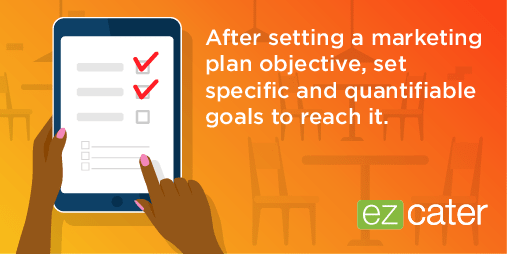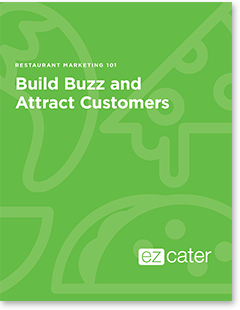Your 7-Step Guide to Creating a Restaurant Marketing Plan that Drives Business
- Ryan Gromfin
- •
- 6 Min Read
- •
The unfortunate truth is that when many caterers or restaurants decide to up their marketing game, they don’t usually create a restaurant marketing plan first. What they don’t realize is that creating a strategy really pays off in the long run. Without a plan, you’re just hoping everything works without any kind of systematic approach. Here are seven steps for creating a restaurant marketing plan that will optimize your efforts toward success.
1. Assess Your Current Business Situation to Set an Objective
What are you trying to gain from your marketing? The first step in creating a restaurant marketing plan is to assess your current business situation and needs. Once you do so, you can attach the proper objective to your plans.
There are three distinct ways to increase your revenue:
- Attract new customers
- Increase the average spend per customer
- Encourage customers to order more often
Once you figure out which revenue stream your business is in need of, you can create a specific plan addressing that objective. It’s a good idea to only work on one at a time, but there’s no reason why you shouldn’t build specific strategies toward all three.
2. Set Your Restaurant’s Marketing Goals
Now that you know why you’re creating your restaurant marketing plan, you need to set goals that mark what it means to reach that objective. They will give you something to measure against to see if you need any course corrections. Your goals should be specific and quantifiable.

Examples of goals include:
- We plan to increase our new catering events from two to four per week in the next six months.
- We plan to bring in 50 new customers by the end of the year.
You will use these goals to determine the increase in top line revenue you’re hoping your marketing plan will bring in.
3. Create a Restaurant Marketing Budget
You may think it’s easier to do this after you have completed your marketing plan. After all, how will you know your budget until you know the plan? But that’s exactly the thinking that gets many restaurants and caterers in trouble. Your budget shouldn’t be the reaction to your plan. It should be an important component of it. You need to determine exactly how much you’re committing to spending on marketing up front.
But how do you know how much you should be spending? First, think about the top line revenues you considered when making your goals. According to Restaurant Marketing Labs, you should then multiply that number by 3 percent. That’s the average number that restaurants spend on marketing. Although if you have more money to spend, you could go as high as 6 percent. You will have to determine your specific needs and then tweak accordingly. But this is a good place to start.
4. Define Your Customers
You’ve probably heard about a “target audience” or “customer persona.” And yet, have you ever really sat down to create one (or two or three) for your business? It can be hard since restaurants and caterers reach a wide audience. You don’t want to narrow it down too much. But it’s difficult to speak to a 45-year old man and a 23-year-old woman in the same marketing voice. They spend their time differently. They have different interests. Just remember that if you try to market to everyone, the odds are, you will connect with nobody.
So, first think about your ideal customer. List their name, age, gender, industry and job title, and the area where they live. And then take it a to another level. List the books and magazines they read. Think about the websites and blogs they visit. If they had an extra hour in the day, what would they use it for? What are the other restaurants they visit and other catering customers they might use?
Now that you know a little about your ideal customer, think about how they react to your specific business. Would they have any objections to using your catering services? What is their role in making a catering decision? Is there anyone else who should be a part of the decision.
The point is to learn to speak in your customer’s language. It’s possible to complete this exercise for multiple customer personas if you think that’s important. But remember that you will need a different restaurant marketing plan for each customer segment.
5. Dig Deeper Into Your Customers’ Needs
If there is a magic bullet in marketing, it’s the “why.” Why is your ideal customer using your catering services? How do you fulfill their needs? Without this “why” — or in other words the problem you’re solving for them — your marketing can become just another distraction.
When creating your restaurant marketing plan, dig into the “why” of your customers’ needs. Start by answering some key questions before and after your using your catering services.
- Before: What do they feel when they think about catering? Are they stressed out or overwhelmed? Is their average day busy, calm, fast, or slow? What is their status at work? And what are their available resources?
- After: Do they now feel more calm and relaxed? Is their day suddenly less hectic? Are they more respected at work for pulling off an important meeting? And are there additional resources for repeat business?
When you understand who they are, what they’re looking for, and how you want your customers to feel after working with you, you can start to work backward to create the marketing that will best suit their needs.
6. Identify Your True Offering
Next, think about what you’re really offering your customers. This is not the place to be sharing your menus and your catering packages. Instead, think about what you’re doing to move customers from that before feelings to the after feelings.
Start by writing three to five promises you can make to your ideal customer. Say your customer is stressed food won’t arrive on time. Your promise could be: “We care about your schedule more than ours.” Or, they’re concerned about offering healthy options, you might say: “We promise to serve the best smoothie bowls ever.”
The purpose of the promises is to help you write a statement of value. A statement of value clearly articulates what sets you apart from the competition. It defines to your ideal customer who you are. Use this formula to start:
[Catering Company Name] [Your Promises]. We are a [Describe Your Company] that helps [Ideal Customer] [Describe Their After Feelings].
Here’s what it can look like in your restaurant marketing plan:
Widget Catering is always on-time with orders and serves foods for any dietary restriction. We are a full-service catering company that helps administrative assistants become the office hero and makes sure everyone has a healthy and happy meal.
7. Put It All Together
The last step in creating your restaurant marketing plan is where the rubber hits the road. You will put everything together to determine exactly what you’re going to do. Here are the questions to answer:
- What type of campaign will you run based on the statements of value you created?
- What is your medium? Digital? Social Media? Print?
- What is the frequency of your marketing based on your budget?
- How will you measure your results? Which tools will you use to measure?
Marketing is not static. You can’t “set it and forget it.” It’s important to check in on your marketing efforts constantly. That way you can decide if there needs to be a shift in spending. Or, you will see red flags that come up along the way, so you can make shifts as needed. But remember that marketing is not so much an expense, as it is an investment in your goals and your future success. Your restaurant marketing plan is designed as guidance along the way so you never lose sight of that.

Looking for more marketing tips? Download our free guide
Looking to grow your catering business? Sign up with ezCater







